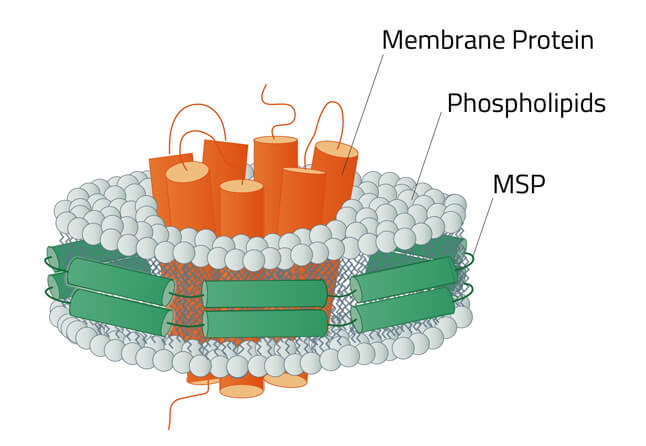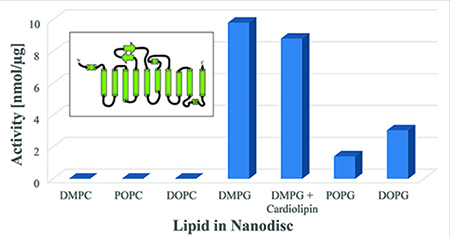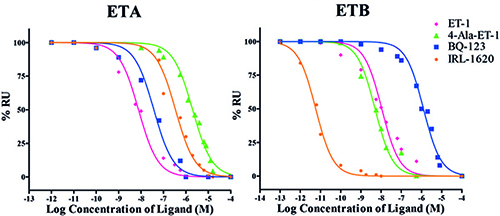Nanodisc MSP1D1 dH5-His POPC (50 µL)
Order number: 26323
Description
Membrane scaffold proteins derive from apolipoprotein (apo; A-I). They are used in membrane protein sciences for the stabilization of membrane proteins in a lipid environment after the removal of the cell membrane. The size of the nanodisc is determined by the MSP that was used to create the disc. MSP1D1 dH5 (His-tagged) creates nanodiscs of ~7-8 nm in diameter.
This product is a pre-assembled nanodisc. Its intended purpose is to stabilize a cell-free expressed membrane protein. There are multiple phospholipids to choose from that can make up the body of the nanodisc. Which is best, depends on your protein.
This product contains a His-tag, keep that in mind when choosing the affinity tag for your membrane protein.
Other MSP products or related sites by Cube Biotech include:
This product is a pre-assembled nanodisc. Its intended purpose is to stabilize a cell-free expressed membrane protein. There are multiple phospholipids to choose from that can make up the body of the nanodisc. Which is best, depends on your protein.
This product contains a His-tag, keep that in mind when choosing the affinity tag for your membrane protein.
Other MSP products or related sites by Cube Biotech include:
- Our "What are nanodiscs?" guide
- Singular Membrane-Scaffold-Proteins (MSPs)
- MSP nanodisc assembly kits (contain both, MS protein and phospholipid, but not pre-assembled)

Datasheets
| Feature (includes data about the MSP protein) | |
|---|---|
| Purity | > 90% (Determined by SDS-PAGE) |
| Number of amino acids | 184 |
| Molecular Mass | 21,468 Da |
| Extinction coefficient (in water) ε280 | 19,940 M-1cm-1 |
| Buffer | 20 mM TRIS pH 7.4; 100 mM NaCl; 0.5 mM EDTA |
| Origin | Human |
| Sequence (1-Letter Code), for more details, see datasheet | MGSSHHHHHH ENLYFQ GSTFSKLREQ LGPVTQEFWD NLEKETEGLR QEMSKDLEEV AKVQPYLDDF QKKWQEEMEL RQKVEPLGEE MRDRARAHVD ALRTHLAPYS DELRQRLAAR LEALKENGGA RLAEYHAKAT EHLSTLSEKA KPALEDLRQG LLPVLESFKV SFLSALEEYT KKLNTQ |
| Affinity tag | N-Terminal His-tag |
| Shipping Temperature | Dry-Ice |
| Storage of reconstituted protein | -80°C, avoid freeze-thaw cycles |
| Helpful literature references |
|
Lab Results


Video
Watch our video tutorial about the creation of MSP nanodiscs. It explains the whole process, starting with the initial solubilzation using detergents. The protein that was stabilized in this demonstration was Bacteriorhodopsin.
We also recommend our video guide to nanodiscs in general.
We also recommend our video guide to nanodiscs in general.
FAQ
Can I get the datasheet for the pre-assembled MSP1D1 dh5 (His-tagged) nanodiscs?
Is this the correct MSP product for my membrane protein?
This cannot be answered easily as every membrane protein performs differently with each nanodisc size and phospholipid. It usually requires a screening process before. Remember that membrane proteins with fewer transmembrane domains (TMD) require a smaller nanodisc, while a high number of TMDs need a larger nanodisc.
What the correct phospholipid for your membrane proteins is, is also protein dependent, unfortunately.
What the correct phospholipid for your membrane proteins is, is also protein dependent, unfortunately.
I have never worked with MSP nanodiscs before. Can you tell me more about them?
Of course! In fact we created THIS MSP NANODISC GUIDE PAGE, for this purpose. Have a look at it!
Are there other options to stabilize membrane proteins besides MSP nanodiscs?
Yes, there are. We recommend synthetic copolmer nanodiscs greatly! Have a look at THIS GUIDE PAGE to learn more.
Disclaimer
Our products are intended for molecular biology applications. These products are not intended for the
diagnosis, prevention, or treatment of a disease.
Nanodiscs are protected by US Patents 7,691,414; 7,662,410; 7,622,437; 7,592,008; 7,575,763; 7,083,958; 7,048,949
Nanodiscs are protected by US Patents 7,691,414; 7,662,410; 7,622,437; 7,592,008; 7,575,763; 7,083,958; 7,048,949



